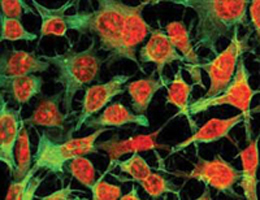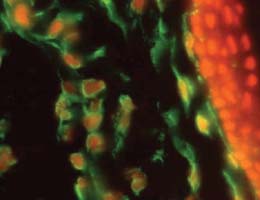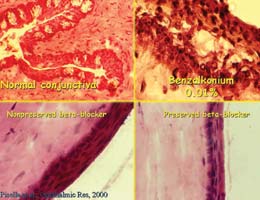Preservative toxicity part of poor glaucoma compliance
When possible, glaucoma medications without preservatives or with nontoxic preservatives should be prescribed, one clinician says.
MADRID — Switching glaucoma patients to preservative-free eyedrops may improve their compliance, a study suggests.
“Preservatives are responsible for poor tolerance of glaucoma eyedrops,” said Christophe Baudouin, MD, PhD, of Paris, at the European Society of Ophthalmology meeting in Madrid.
Preservatives in glaucoma medications can cause inflammation and toxicity, he said. Listening to patient complaints about their medications and monitoring the condition of the ocular surface may provide clues to improving patient compliance, he said. Switching to a preservative-free glaucoma medication or one with a nontoxic preservative may improve patient tolerance.
Prof. Baudouin recommended that patients be evaluated for toxicity to the ocular surface periodically — certainly after 4 years of monotherapy or 1 year of therapy with two or more drugs, he said.
Often, he said, the appearance of toxicity is not associated with the development of ocular allergy.
“We are used to observing ocular allergy 1 or 2 days after instillation of a new drug, but sometimes it may be difficult to observe,” he said.
In conjunctival biopsies taken from patients after prolonged use of preserved medications, inflammatory infiltrates have been seen, he said. These infiltrates can lead to a variety of allergic conditions.
BAK toxicity studies
Benzalkonium chloride (BAK), the preservative most often used in antiglaucoma drugs, has been associated with allergic reactions and other ocular disorders, Prof. Baudouin said. BAK has direct toxicity on the epithelial and goblet cells and an indirect toxic effect on the lacrimal film through its tensioactive properties, he added.
Prof. Baudouin and colleagues have evaluated the effects of BAK on the ocular surface in both clinical and lab studies. He described the results of several studies performed in Paris and Boulogne for which he was the coordinator.
At concentrations of between 0.0001% and 0.005%, BAK can induce apoptosis through reduction of cell volume, nuclear size and cytoskeleton, he said. At these concentrations, BAK alters the cell cycle, increases the expression of a marker for apoptosis and inhibits cell growth. At concentrations of between 0.01% and 0.1%, BAK can induce cell necrosis, with cytotoxicity, chromatin condensation and membrane disruption.
In an in vitro study, Prof. Baudouin and colleagues at the University of Paris compared the effects of timolol with and without BAK as a preservative. With the preserved formulation they observed irreversible cytotoxic damage with characteristics of apoptosis.
In this in vitro study, in a model of conjunctival cells after treatment with timolol containing BAK, there was a rapid decrease in cell viability, ranging from 40% immediately after treatment to 85% 24 hours later. In addition, cells treated with timolol plus BAK showed an increased level of the apoptotic marker Apo 2.7.
These findings suggest that the preservative can cause ocular disorders in patients taking preserved medications chronically, Prof. Baudouin said.
|
|
|
 |  |
Control tissue (left) is compared to tissue exposed to BAK 0.01%. | |
In another study, tissue samples were obtained from 61 patients undergoing trabeculectomy. Twenty-six patients had been treated with two or more drugs for at least 1 year, 30 more had been treated with a beta-blocker for at least 1 year and 5 were undergoing primary surgery for glaucoma.
Specimens of trabeculum and conjunctiva were examined immunohistochemically for inflammatory cell infiltrates, fibroblasts and other histologic changes. Twenty-four of 26 pieces of conjunctiva obtained from the patients treated with multiple drugs were abnormally infiltrated by cells expressing inflammatory or fibroblastic markers. Nineteen of 30 conjunctival samples from patients treated with monotherapy were abnormal, and only one of five samples from patients undergoing primary surgery were abnormal.
The study suggests that BAK had induced the toxic and immunoinflammatory effects on the ocular structures, which could affect the outcome of filtration surgery, Prof. Baudouin said.
Listen to patients
Prof. Baudouin also described a survey conducted by 249 physicians on 4,107 patients to determine the incidence of ocular toxicity from preservatives in glaucoma medications.
The study showed that eyedrops with BAK were more likely to cause discomfort, burning, stinging sensations, foreign body sensation, dry eye sensation, tearing and eyelid itching. The prevalence of these symptoms in the study was dose-dependent, increasing with the number of preserved drops patients were taking. Switching to eyedrops with preservative-free or nontoxic preservatives improved tolerance, as did reducing the number of drops, Prof. Baudouin said.
“The survey … demonstrates well the clinical aspects of preservative toxicity in real-life use,” he said.
For Your Information:References:
- Christophe Baudouin, MD, PhD, can be reached at Quinze-Vingts National Ophthalmology Hospital, University of Paris-VI, 28 Rue Charenton, Paris 75012 France; (33) 1-49-09-55-08; fax: (33) 1-49-09-59-11; e-mail: chrbaudouin@aol.com.
- Brignole F. Apoptosis and the ocular surface. J Fr Ophtalmol. 2003;26:299-306.
- Pisella PJ. Prevalence of ocular symptoms and signs with preserved and preservative free glaucoma medication. Br J Ophthalmol. 2002;86:418-423.
- Baudouin C. When should glaucoma be surgically treated. J Fr Ophtalmol. 2001;24(10):1103-1109.
- De Saint Jean M. Toxicity of preserved and unpreserved antiglaucoma topical drugs in an in vitro model of conjunctival cells. Curr Eye Res. 2000;20:85-94.
- Baudouin C. Ocular surface inflammatory changes induced by topical antiglaucoma drugs; human and animal studies. Ophthalmology. 1999;106:556-563.
- De Saint Jean M. Effects of benzalkonium chloride on growth and survival of Chang conjunctival cells. Invest Ophthalmol Vis Sci. 1999;40:619-30.


